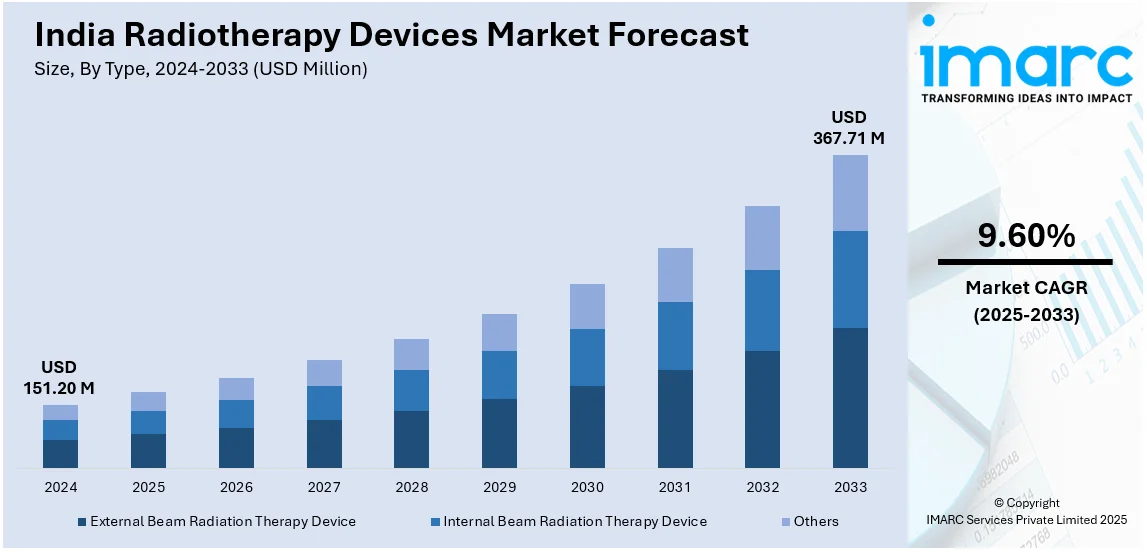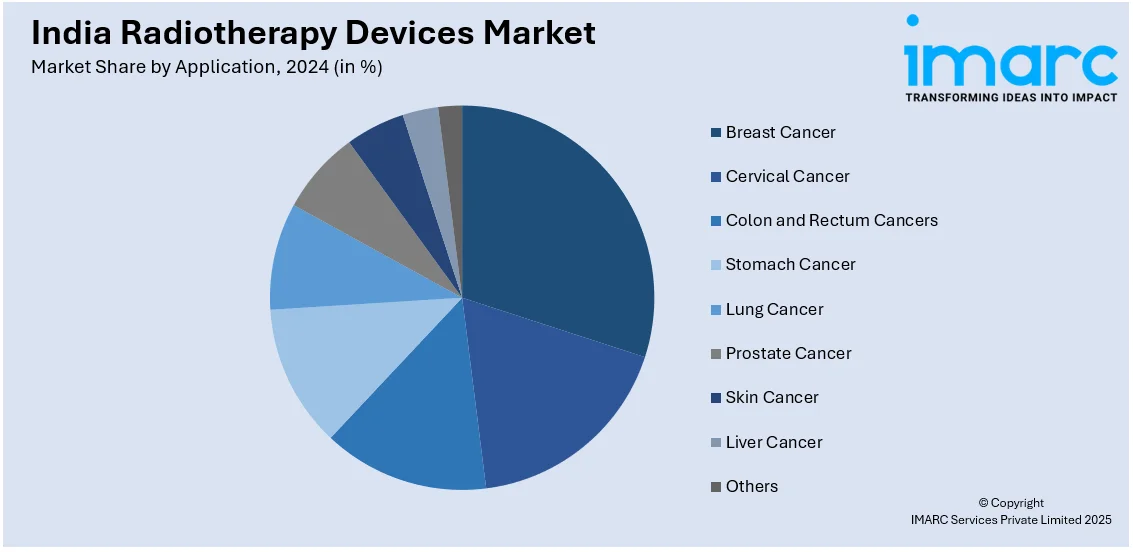
India Radiotherapy Devices Market Size, Share, Trends and Forecast by Type, Application, End User, and Region, 2025-2033
India Radiotherapy Devices Market Overview:
The India radiotherapy devices market size reached USD 151.20 Million in 2024. Looking forward, IMARC Group expects the market to reach USD 367.71 Million by 2033, exhibiting a growth rate (CAGR) of 9.60% during 2025-2033. The market is growing steadily owing to the rising prevalence of cancer, increasing expenditure on healthcare, and technological improvements in radiation therapy. Market growth is being spurred by demand for precision medicine-based treatments, government programs, and growing cancer treatment infrastructure.
|
Report Attribute
|
Key Statistics
|
|---|---|
|
Base Year
|
2024 |
|
Forecast Years
|
2025-2033
|
|
Historical Years
|
2019-2024
|
| Market Size in 2024 | USD 151.20 Million |
| Market Forecast in 2033 | USD 367.71 Million |
| Market Growth Rate (2025-2033) | 9.60% |
India Radiotherapy Devices Market Trends:
Growing Adoption of Advanced Radiotherapy Techniques
India is also undergoing a dramatic shift toward newer forms of radiotherapy such as stereotactic body radiation therapy (SBRT), intensity-modulated radiation therapy (IMRT), and proton therapy. For instance, in June 2024, Apollo Cancer Centres and Accuray opened India's first Robotic Stereotactic Radiotherapy Program, offering enhanced CyberKnife training to oncologists across India and the ASEAN region in Chennai and Bangalore. Moreover, the newer technologies allow precise targeting of tumors with reduced damage to nearby healthy tissues, leading to improved treatment results and fewer side effects. The increase in demand for high-accuracy radiation therapy is driven by an increase in cancer incidence and a requirement for more effective and patient-friendly therapies. In addition, integration of artificial intelligence (AI) and image-guided radiation therapy (IGRT) is maximizing the process of planning and delivering treatment with more accuracy and efficiency. As standards of cancer treatment are sought to be enhanced by medical professionals, the application of such sophisticated radiotherapy techniques is expected to grow. But barriers such as high technology and specialized training remain significant hurdles to the widespread deployment, particularly in rural and underdeveloped regions.

Increasing Investment in Cancer Care Infrastructure
India has witnessed huge growth in investment for enhanced cancer care facilities, especially radiotherapy centers. Due to increasing cases of cancer, both public and private health systems are proactively attempting to overcome the deficiency of access to new-age treatment modalities. For example, in February 2023, CHL Hospitals Indore, in association with Elekta, introduced the Elekta Harmony system, India's first precision radiotherapy linac, increasing advanced cancer treatment availability and improving radiotherapy capacity in Madhya Pradesh. Furthermore, several initiatives have been launched by the government for strengthening oncology care, such as setting up regional cancer centers and upgrading old hospitals with the latest radiotherapy machines. In addition, there is an increasing investment in upscale radiation therapy facilities by private health providers to deliver world-class care, driven by the demand for quality cancer services. With such advancements, there is still access to radiotherapy as a difficulty in rural parts of the country, where radiotherapy facilities tend to be in short supply. This shortfall is being tackled using mobile radiotherapy units and telemedicine-based planning. With ongoing investment, India's radiotherapy infrastructure will become stronger, paving the way for increased accessibility and better outcomes for patients.
Rise of Personalized Radiotherapy Treatments
Personalized radiotherapy is becoming popular in India as technological advances in medical imaging, AI, and biomarker-based planning of treatment revolutionalize cancer treatment. In contrast to traditional one-size-fits-all options, personalized radiotherapy customizes treatment according to a patient's tumor features, genetic make-up, and radiation sensitivity. Treatments such as adaptive radiotherapy, which adjusts treatment in real time due to tumor regression or patient anatomical changes, are becoming increasingly common. The incorporation of AI-based radiotherapy planning is also refining the delivery of the dose, decreasing side effects, and enhancing survival. Further, research on radio-genomics that assists in examining how an individual's genetic profile affects their radiological response is therefore, opening doors to even more tailored treatments. Albeit possible advantages, some hurdles like the expense of personalized therapy and demand for specialized skills might hinder extensive uptake. But with technology getting more advanced and readily available, customized radiotherapy will be a central factor in India's changing cancer scene.
India Radiotherapy Devices Market Segmentation:
IMARC Group provides an analysis of the key trends in each segment of the market, along with forecasts at the region level for 2025-2033. Our report has categorized the market based on type, application and end user.
Type Insights:
- External Beam Radiation Therapy Device
- Internal Beam Radiation Therapy Device
- Others
The report has provided a detailed breakup and analysis of the market based on the type. This includes external beam radiation therapy device, internal beam radiation therapy device, and others.
Application Insights:

- Breast Cancer
- Cervical Cancer
- Colon and Rectum Cancers
- Stomach Cancer
- Lung Cancer
- Prostate Cancer
- Skin Cancer
- Liver Cancer
- Others
A detailed breakup and analysis of the market based on the application have also been provided in the report. This includes breast cancer, cervical cancer, colon and rectum cancers, stomach cancer, lung cancer, prostate cancer, skin cancer, liver cancer, and others.
End User Insights:
- Hospitals and Clinics
- Cancer Care Centers
- Others
The report has provided a detailed breakup and analysis of the market based on the end user. This includes hospitals and clinics, cancer care centers, and others.
Regional Insights:
- North India
- South India
- East India
- West India
The report has also provided a comprehensive analysis of all the major regional markets, which include North, South, East, and West India.
Competitive Landscape:
The market research report has also provided a comprehensive analysis of the competitive landscape. Competitive analysis such as market structure, key player positioning, top winning strategies, competitive dashboard, and company evaluation quadrant has been covered in the report. Also, detailed profiles of all major companies have been provided.
India Radiotherapy Devices Market News:
- In October 2024, Aster DM Healthcare launched India's first Intra-Operative Electron Radiation Therapy (IOeRT) at Aster Whitefield Hospital, Bengaluru. This advanced technology increases the accuracy of cancer treatment through targeted radiation during procedures, lowering follow-up sessions post-surgery, fewer side effects, and better patient outcomes, creating a new standard in oncology care.
- In November 2024, the Sri Ramakrishna Institute of Oncology and Research in Tamil Nadu was the first comprehensive cancer center in Southern Tamil Nadu to bring in the Tomotherapy Radixact X9. This cutting-edge radiation therapy system provides accurate, image-guided treatment, enhancing tumor targeting and minimizing damage to surrounding tissues.
India Radiotherapy Devices Market Report Coverage:
| Report Features | Details |
|---|---|
| Base Year of the Analysis | 2024 |
| Historical Period | 2019-2024 |
| Forecast Period | 2025-2033 |
| Units | Million USD |
| Scope of the Report |
Exploration of Historical Trends and Market Outlook, Industry Catalysts and Challenges, Segment-Wise Historical and Future Market Assessment:
|
| Types Covered | External Beam Radiation Therapy Device, Internal Beam Radiation Therapy Device, Others |
| Applications Covered | Breast Cancer, Cervical Cancer, Colon and Rectum Cancers, Stomach Cancer, Lung Cancer, Prostate Cancer, Skin Cancer, Liver Cancer, Others |
| End Users Covered | Hospitals and Clinics, Cancer Care Centers, Others |
| Regions Covered | North India, South India, East India, West India |
| Customization Scope | 10% Free Customization |
| Post-Sale Analyst Support | 10-12 Weeks |
| Delivery Format | PDF and Excel through Email (We can also provide the editable version of the report in PPT/Word format on special request) |
Key Questions Answered in This Report:
- How has the India radiotherapy devices market performed so far and how will it perform in the coming years?
- What is the breakup of the India radiotherapy devices market on the basis of type?
- What is the breakup of the India radiotherapy devices market on the basis of application?
- What is the breakup of the India radiotherapy devices market on the basis of end user?
- What is the breakup of the India radiotherapy devices market on the basis of region?
- What are the various stages in the value chain of the India radiotherapy devices market?
- What are the key driving factors and challenges in the India radiotherapy devices?
- What is the structure of the India radiotherapy devices market and who are the key players?
- What is the degree of competition in the India radiotherapy devices market?
Key Benefits for Stakeholders:
- IMARC’s industry report offers a comprehensive quantitative analysis of various market segments, historical and current market trends, market forecasts, and dynamics of the India radiotherapy devices market from 2019-2033.
- The research report provides the latest information on the market drivers, challenges, and opportunities in the India radiotherapy devices market.
- Porter's five forces analysis assist stakeholders in assessing the impact of new entrants, competitive rivalry, supplier power, buyer power, and the threat of substitution. It helps stakeholders to analyze the level of competition within the India radiotherapy devices industry and its attractiveness.
- Competitive landscape allows stakeholders to understand their competitive environment and provides an insight into the current positions of key players in the market.
Need more help?
- Speak to our experienced analysts for insights on the current market scenarios.
- Include additional segments and countries to customize the report as per your requirement.
- Gain an unparalleled competitive advantage in your domain by understanding how to utilize the report and positively impacting your operations and revenue.
- For further assistance, please connect with our analysts.
 Inquire Before Buying
Inquire Before Buying
 Speak to an Analyst
Speak to an Analyst
 Request Brochure
Request Brochure
 Request Customization
Request Customization




.webp)




.webp)












